Abstract
A 4-year-old girl with multiple malformations and severe developmental delay has been shown to have a karyotype of 46,XX-9,+rec(9),dup p,inv(9) (q22.1q34.3)mat, with duplication 9pter-q22.1 and deficiency 9q34.3-qter. This case confirms that a stable recombinant chromosome can result from a paracentric inversion. The recombinant was derived by two crossovers, one within the inversion loop and a second outside the inversion loop, between 9q21 and the beginning of the meiotic inversion at 9q22.1. In 87 cells the rec(9) had one Cd-positive primary constriction. In 13 cells the rec(9) had two primary constrictions; in 12 of these cells there was one Cd-positive centromere, and in one of these cells both primary constrictions were Cd-positive. Nuclear projections were observed in 10% of fibroblast interphase cells harvested in situ, suggesting that there was some spindle-fiber activity of the "latent" centromere. In situ hybridization with a centromere-specific probe (p82H) and a satellite III probe (L6) revealed no differences between the two C-band regions of the rec(9) and the normal 9 or inverted 9 chromosomes.
Full text
PDF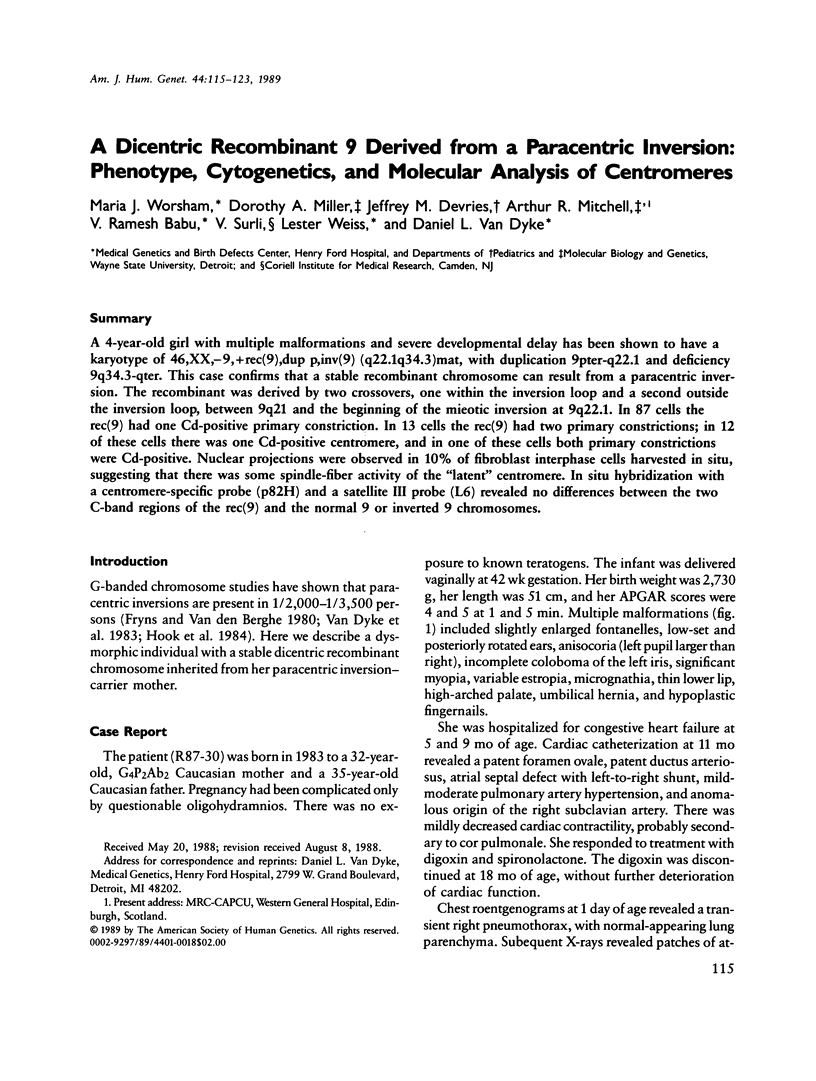
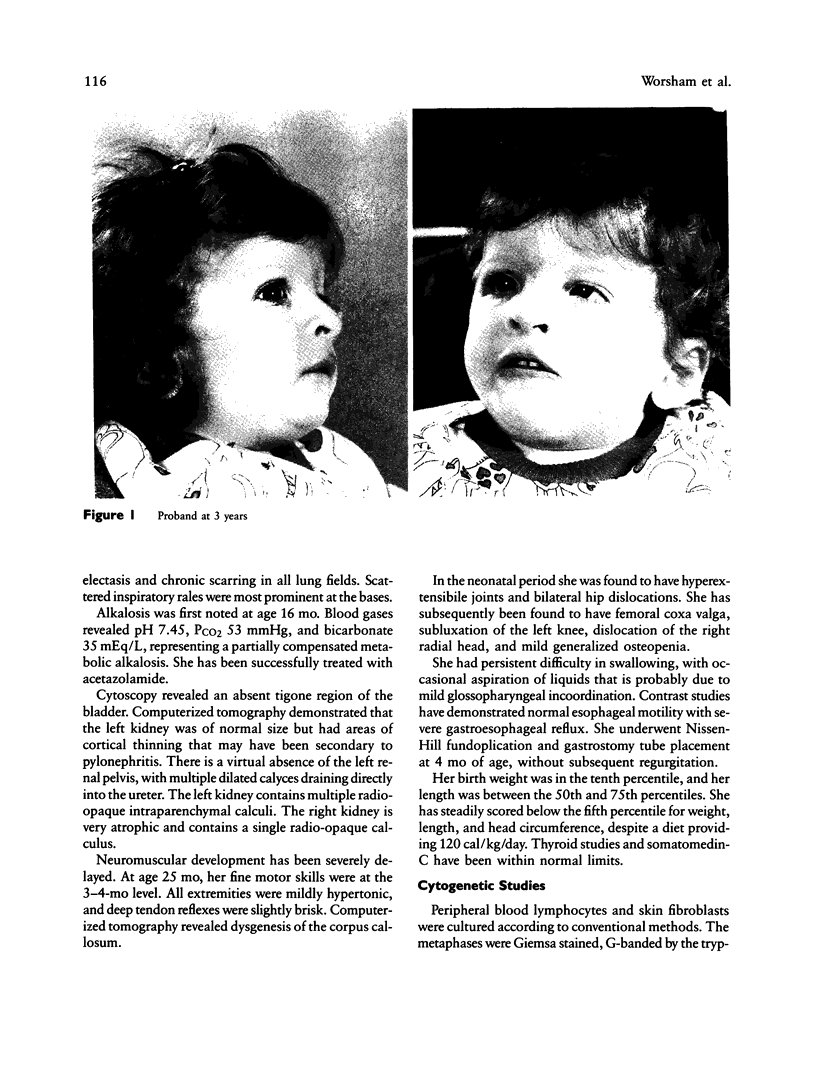
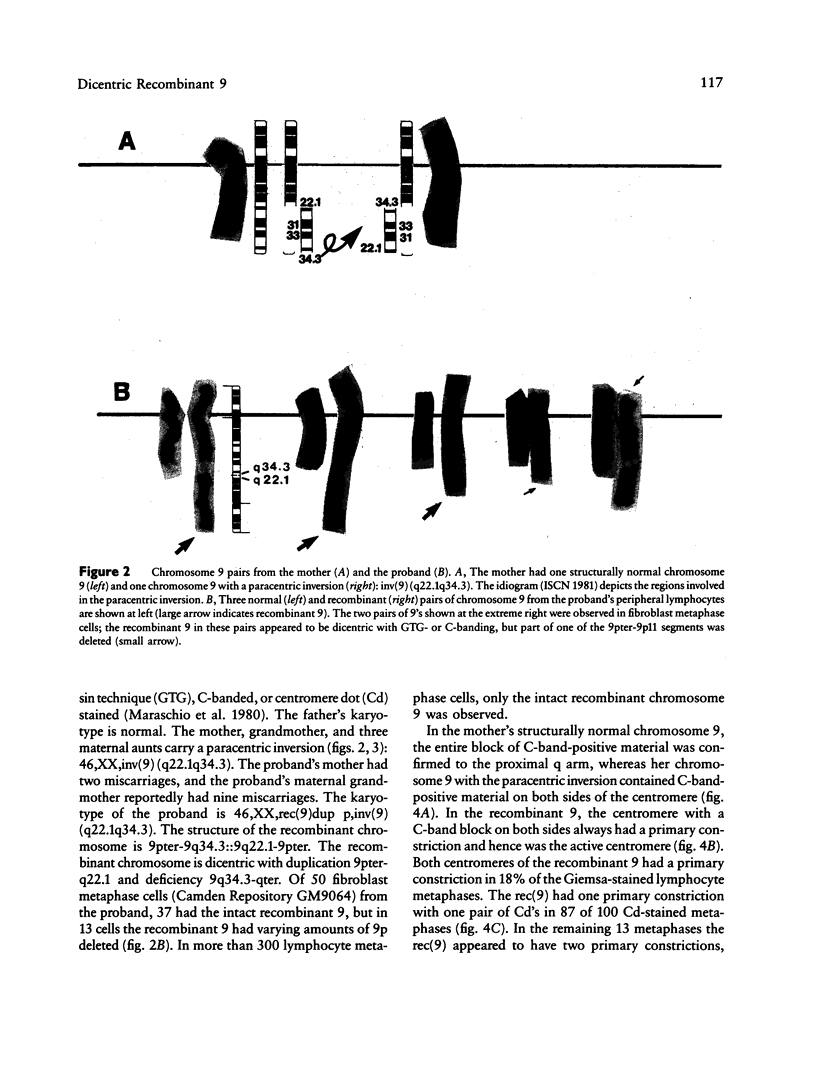
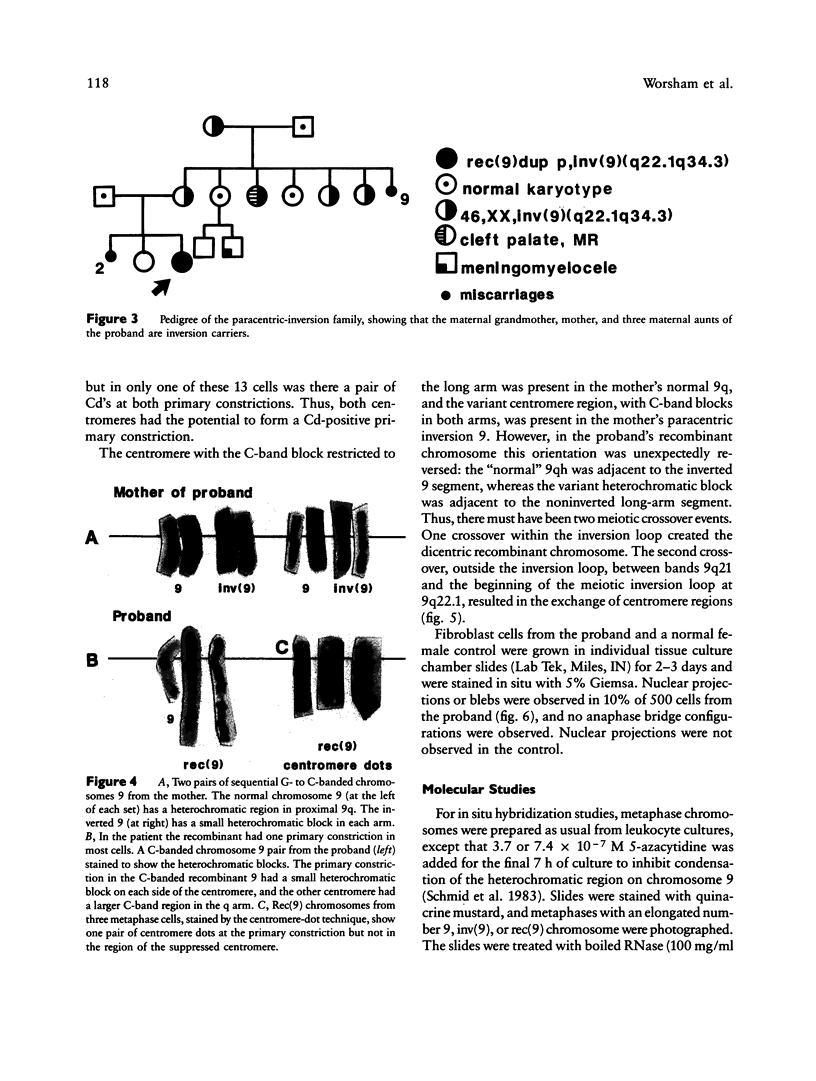
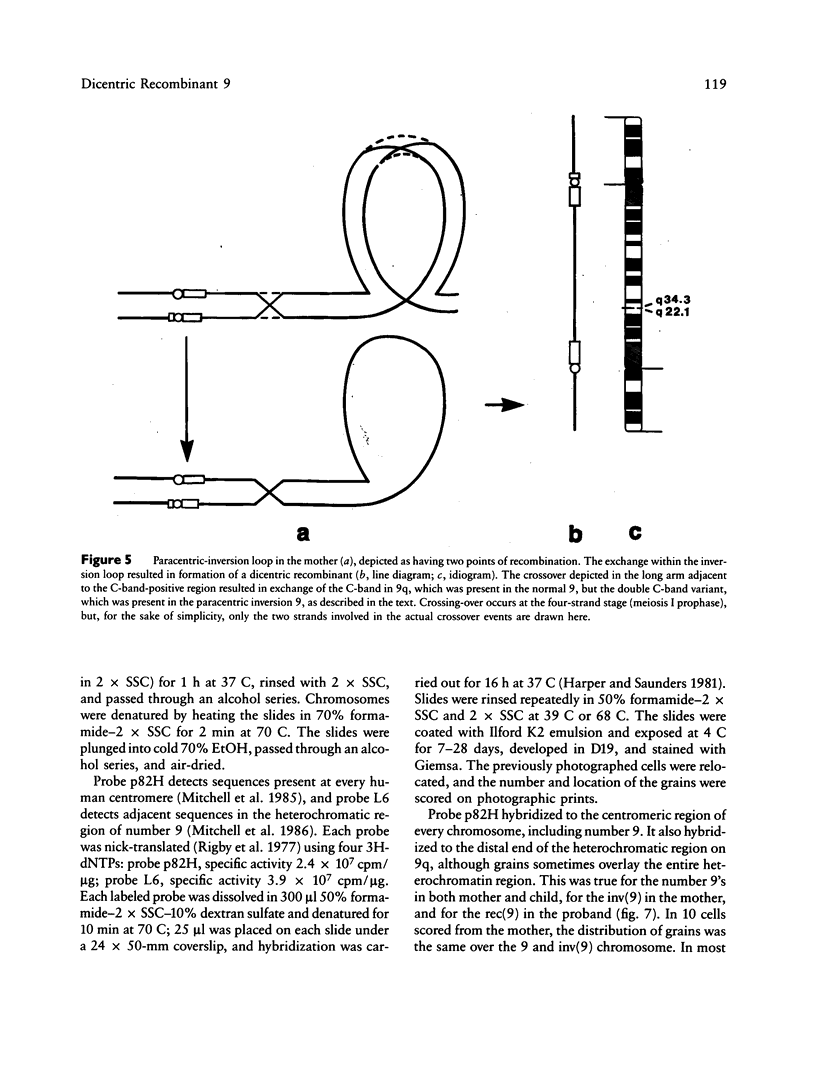
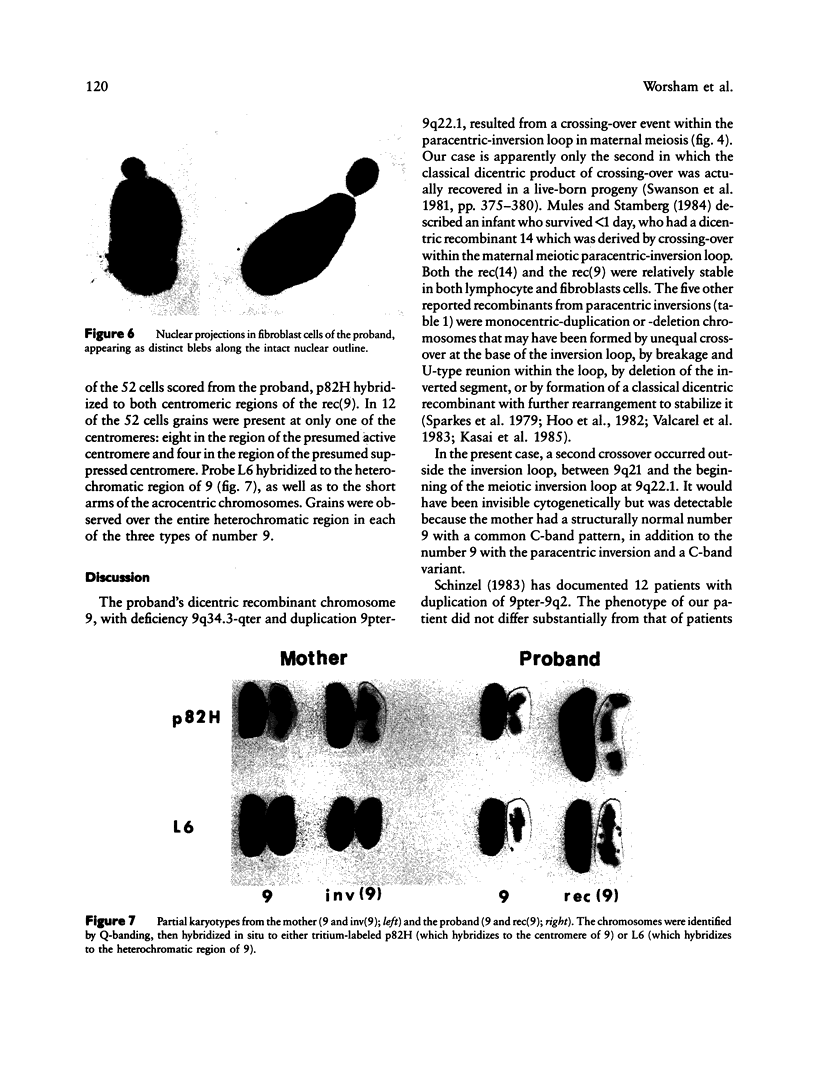
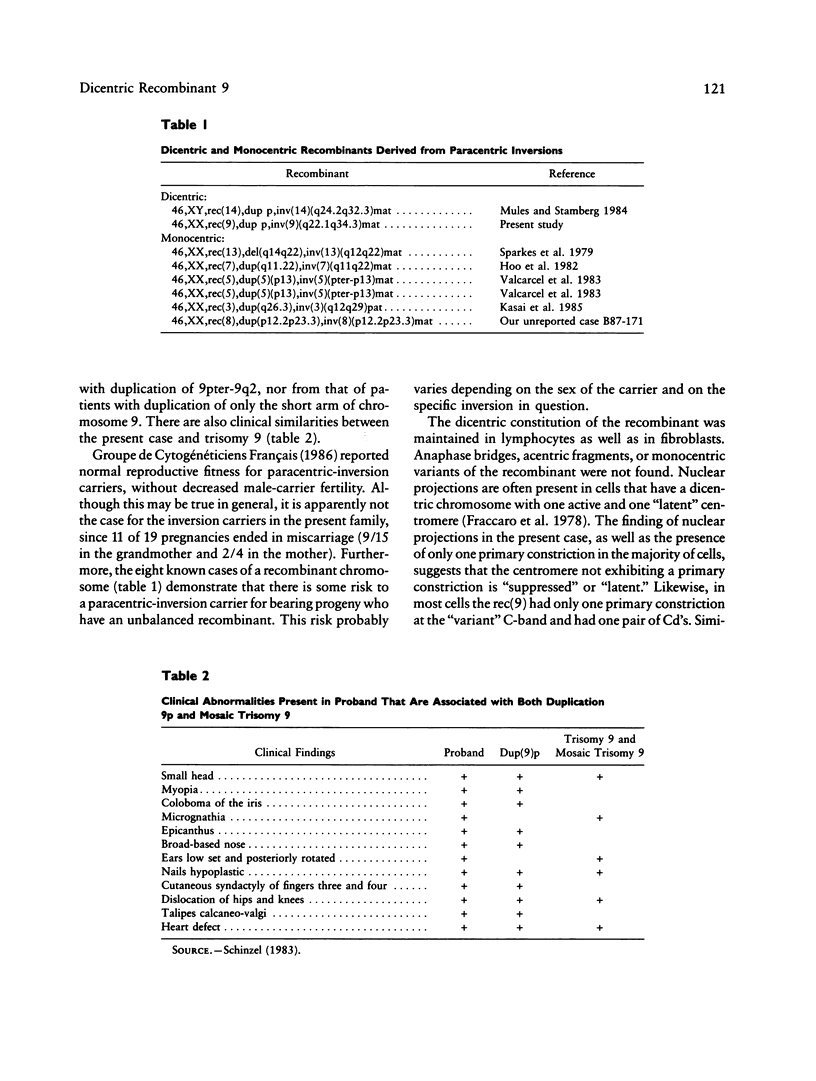
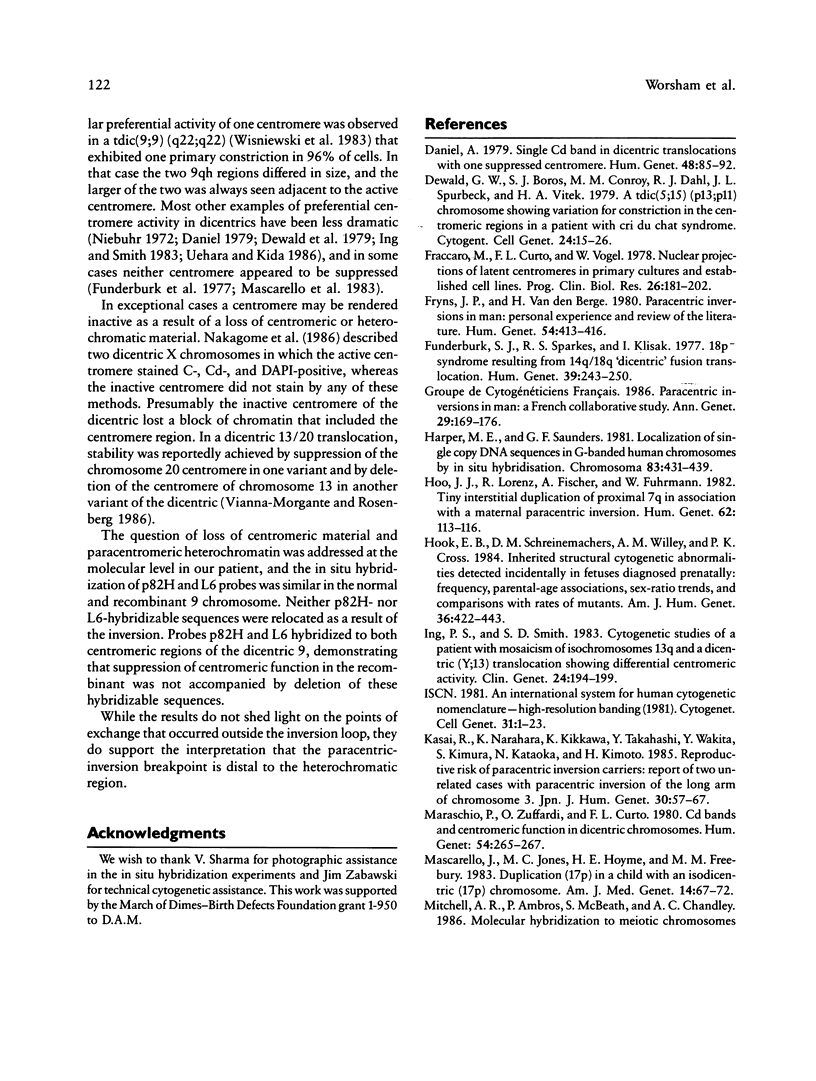
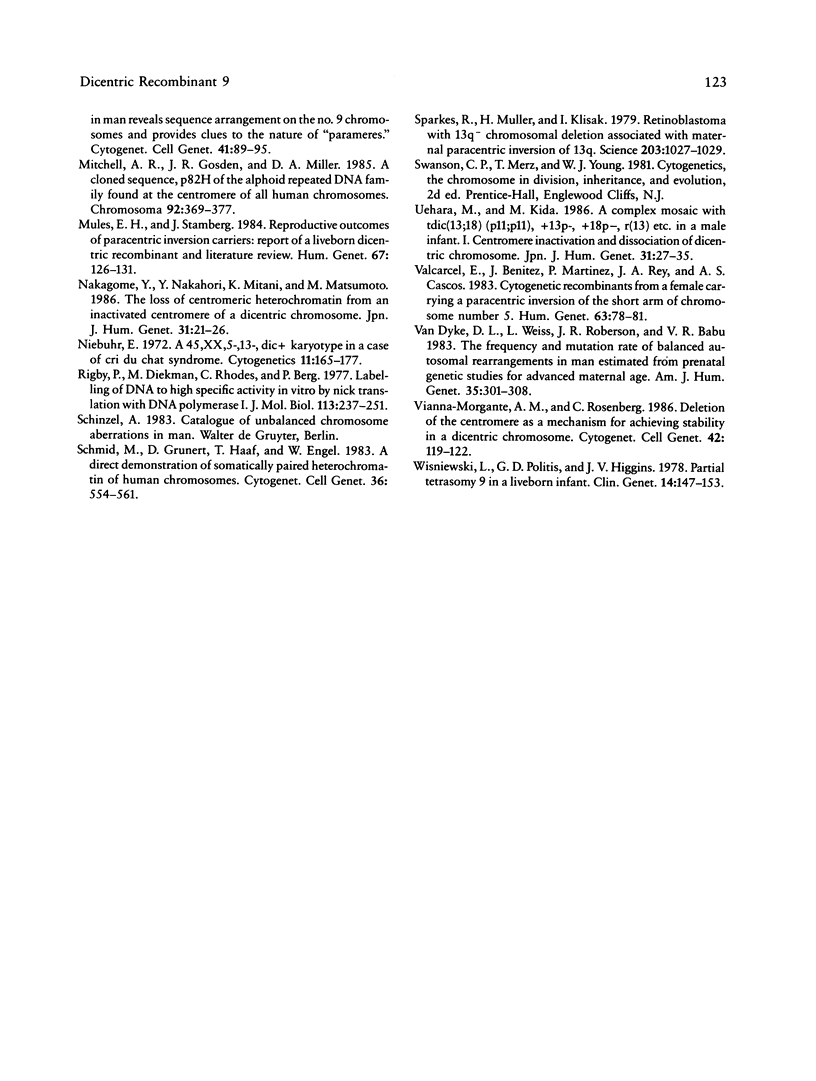
Images in this article
Selected References
These references are in PubMed. This may not be the complete list of references from this article.
- Daniel A. Single Cd band in dicentric translocations with one suppressed centromere. Hum Genet. 1979 Apr 17;48(1):85–92. doi: 10.1007/BF00273279. [DOI] [PubMed] [Google Scholar]
- Dewald G. W., Boros S. J., Conroy M. M., Dahl R. J., Spurbeck J. L., Vitek H. A. A tdic(5;15)(p31;p11) chromosome showing variation for constriction in the centromeric regions in a patient with the cri du chat syndrome. Cytogenet Cell Genet. 1979;24(1):15–26. doi: 10.1159/000131352. [DOI] [PubMed] [Google Scholar]
- Fraccaro M., Lo Curto F., Vogel W. Nuclear projections and latent centromeres in primary cultures and established cell lines. Prog Clin Biol Res. 1978;26:181–202. [PubMed] [Google Scholar]
- Fryns J. P., Van den Berghe H. Paracentric Inversion in man: personal experience and review of the literature. Hum Genet. 1980;54(3):413–416. doi: 10.1007/BF00291590. [DOI] [PubMed] [Google Scholar]
- Funderburk S. J., Sparkes R. S., Klisak I. 18p--syndrome resulting from 14q/18q 'dicentric' fusion translocation. Hum Genet. 1977 Nov 10;39(2):243–250. doi: 10.1007/BF00287020. [DOI] [PubMed] [Google Scholar]
- Harper M. E., Saunders G. F. Localization of single copy DNA sequences of G-banded human chromosomes by in situ hybridization. Chromosoma. 1981;83(3):431–439. doi: 10.1007/BF00327364. [DOI] [PubMed] [Google Scholar]
- Hoo J. J., Lorenz R., Fischer A., Fuhrmann W. Tiny interstitial duplication of proximal 7q in association with a maternal paracentric inversion. Hum Genet. 1982;62(2):113–116. doi: 10.1007/BF00282296. [DOI] [PubMed] [Google Scholar]
- Hook E. B., Schreinemachers D. M., Willey A. M., Cross P. K. Inherited structural cytogenetic abnormalities detected incidentally in fetuses diagnosed prenatally: frequency, parental-age associations, sex-ratio trends, and comparisons with rates of mutants. Am J Hum Genet. 1984 Mar;36(2):422–443. [PMC free article] [PubMed] [Google Scholar]
- Ing P. S., Smith S. D. Cytogenetic studies of a patient with mosaicism of isochromosome 13q and a dicentric (Y;13) translocation showing differential centromeric activity. Clin Genet. 1983 Sep;24(3):194–199. doi: 10.1111/j.1399-0004.1983.tb02239.x. [DOI] [PubMed] [Google Scholar]
- Kasai R., Narahara K., Kikkawa K., Takahashi Y., Wakita Y., Kimura S., Kataoka N., Kimoto H. Reproductive risk of paracentric inversion carriers: report of two unrelated cases with paracentric inversion of the long arm of chromosome 3. Jinrui Idengaku Zasshi. 1985 Jun;30(2):57–67. doi: 10.1007/BF01873578. [DOI] [PubMed] [Google Scholar]
- Maraschio P., Zuffardi O., Lo Curto F. Cd bands and centromeric function in dicentric chromosomes. Hum Genet. 1980;54(2):265–267. doi: 10.1007/BF00278982. [DOI] [PubMed] [Google Scholar]
- Mascarello J. T., Jones M. C., Hoyme H. E., Freebury M. M. Duplication (17p) in a child with an isodicentric (17p) chromosome. Am J Med Genet. 1983 Jan;14(1):67–72. doi: 10.1002/ajmg.1320140111. [DOI] [PubMed] [Google Scholar]
- Mitchell A. R., Ambros P., McBeath S., Chandley A. C. Molecular hybridization to meiotic chromosomes in man reveals sequence arrangement on the no. 9 chromosome and provides clues to the nature of "parameres". Cytogenet Cell Genet. 1986;41(2):89–95. doi: 10.1159/000132209. [DOI] [PubMed] [Google Scholar]
- Mitchell A. R., Gosden J. R., Miller D. A. A cloned sequence, p82H, of the alphoid repeated DNA family found at the centromeres of all human chromosomes. Chromosoma. 1985;92(5):369–377. doi: 10.1007/BF00327469. [DOI] [PubMed] [Google Scholar]
- Mules E. H., Stamberg J. Reproductive outcomes of paracentric inversion carriers: report of a liveborn dicentric recombinant and literature review. Hum Genet. 1984;67(2):126–131. doi: 10.1007/BF00272986. [DOI] [PubMed] [Google Scholar]
- Nakagome Y., Nakahori Y., Mitani K., Matsumoto M. The loss of centromeric heterochromatin from an inactivated centromere of a dicentric chromosome. Jinrui Idengaku Zasshi. 1986 Mar;31(1):21–26. doi: 10.1007/BF01876798. [DOI] [PubMed] [Google Scholar]
- Niebuhr E. A 45,XX,5-,13-,dic+ karyotype in a case of cri-du-chat syndrome. Cytogenetics. 1972;11(3):165–177. doi: 10.1159/000130186. [DOI] [PubMed] [Google Scholar]
- Rigby P. W., Dieckmann M., Rhodes C., Berg P. Labeling deoxyribonucleic acid to high specific activity in vitro by nick translation with DNA polymerase I. J Mol Biol. 1977 Jun 15;113(1):237–251. doi: 10.1016/0022-2836(77)90052-3. [DOI] [PubMed] [Google Scholar]
- Schmid M., Grunert D., Haaf T., Engel W. A direct demonstration of somatically paired heterochromatin of human chromosomes. Cytogenet Cell Genet. 1983;36(3):554–561. doi: 10.1159/000131972. [DOI] [PubMed] [Google Scholar]
- Sparkes R. S., Muller H., Klisak I. Retinoblastoma with 13q- chromosomal deletion associated with maternal paracentric inversion of 13q. Science. 1979 Mar 9;203(4384):1027–1029. doi: 10.1126/science.424728. [DOI] [PubMed] [Google Scholar]
- Uehara M., Kida M. A complex mosaic with tdic(13;18) (p11;p11), +13p-, +18p-, r(13) etc. in a male infant. I. Centromere inactivation and dissociation of dicentric chromosome. Jinrui Idengaku Zasshi. 1986 Mar;31(1):27–35. doi: 10.1007/BF01876799. [DOI] [PubMed] [Google Scholar]
- Valcárcel E., Benítez J., Martínez P., Rey J. A., Sánchez Cascos A. Cytogenetic recombinants from a female carrying a paracentric inversion of the short arm of chromosome number 5. Hum Genet. 1983;63(1):78–81. doi: 10.1007/BF00285405. [DOI] [PubMed] [Google Scholar]
- Van Dyke D. L., Weiss L., Roberson J. R., Babu V. R. The frequency and mutation rate of balanced autosomal rearrangements in man estimated from prenatal genetic studies for advanced maternal age. Am J Hum Genet. 1983 Mar;35(2):301–308. [PMC free article] [PubMed] [Google Scholar]
- Vianna-Morgante A. M., Rosenberg C. Deletion of the centromere as a mechanism for achieving stability of a dicentric chromosome. Cytogenet Cell Genet. 1986;42(3):119–122. doi: 10.1159/000132263. [DOI] [PubMed] [Google Scholar]
- Wisniewski L., Politis G. D., Higgins J. V. Partial tetrasomy 9 in a liveborn infant. Clin Genet. 1978 Sep;14(3):147–153. doi: 10.1111/j.1399-0004.1978.tb02120.x. [DOI] [PubMed] [Google Scholar]







